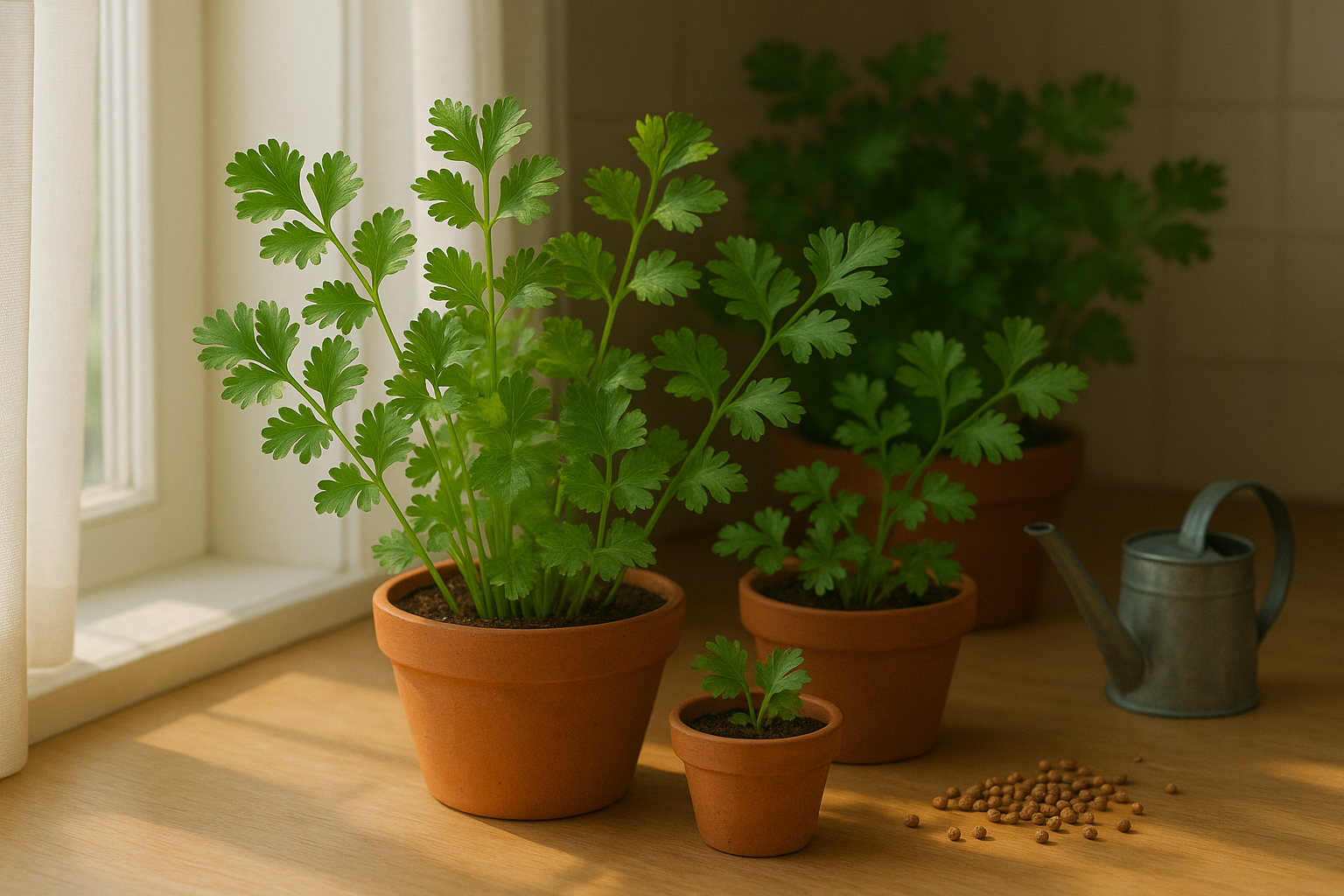Introduction & Benefits of Growing Cilantro Indoors
Growing cilantro indoors is a fantastic way to enjoy this versatile herb year-round, no matter the weather outside. Known for its distinctive flavor and vibrant green leaves, cilantro is a staple in kitchens worldwide, adding a fresh, zesty kick to everything from salsa and curries to salads and soups. Its popularity isn’t just about taste—cilantro is packed with nutrients like vitamins A, C, and K, making it a healthy addition to countless recipes.
By growing cilantro indoors, you gain the unbeatable convenience of harvesting fresh leaves whenever you need them, right from your windowsill or countertop. Unlike store-bought bunches, which can wilt and lose their potency within a few days, homegrown cilantro is always at peak freshness, bursting with flavor and aroma. Plus, you don’t have to worry about pesticides or questionable storage conditions that supermarket herbs might face.
From a cost perspective, cultivating cilantro indoors quickly becomes more economical than frequent trips to the store. A packet of seeds and a pot can yield harvests for months, saving you money and reducing food waste. Indoor gardening also helps you avoid common outdoor challenges like pests, unpredictable weather, or unsuitable climates. No matter where you live—even in an apartment or a region with harsh winters—you can create the perfect environment for lush, healthy cilantro.
Ultimately, growing cilantro indoors gives you greater control, fresher herbs, and a constant supply of this beloved ingredient, making it a rewarding and practical choice for cooks and home gardeners alike.
Getting Started
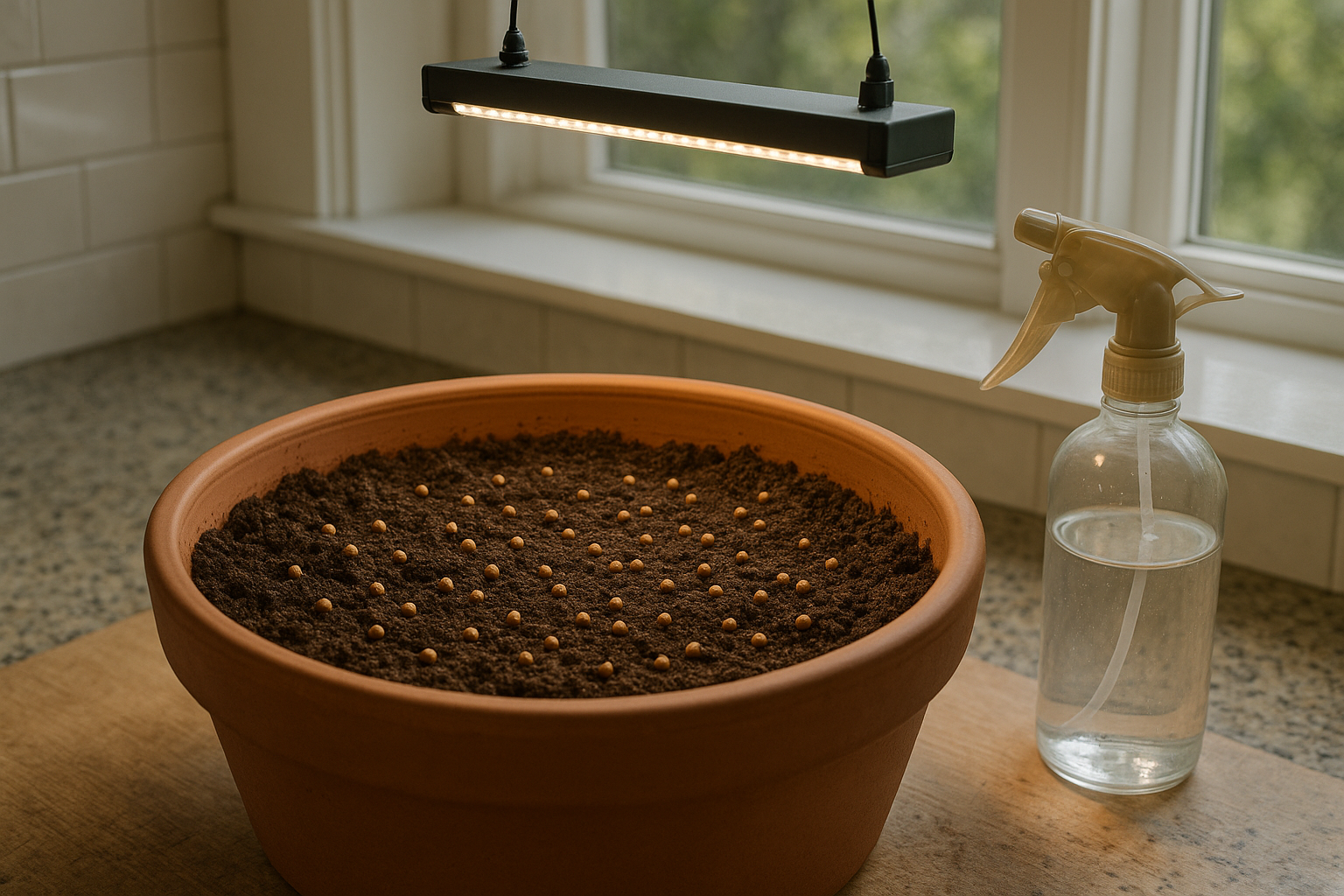
Growing cilantro indoors is a rewarding way to keep fresh herbs within reach, but having the right setup is crucial for success. Start with a container that’s at least 8 inches deep, as cilantro develops long roots, and cramped pots can lead to stunted plants. Choose pots with good drainage holes—soggy roots are a recipe for wilt and disease, so always place a small tray underneath to catch excess water.
Use a lightweight, well-draining potting mix rather than garden soil, which can get compacted and suffocate roots indoors. For planting, you have two options: sowing seeds or transplanting seedlings. Starting from seed is often cheaper and lets you skip the shock seedlings sometimes experience when moved, but seeds can take up to three weeks to sprout and require patience for thinning and spacing.
Seedlings, on the other hand, offer a quicker route to harvest, but make sure they’re acclimated to your indoor environment to reduce the risk of transplant shock. Cilantro thrives best at 65–75°F, so keep your pots in a mild spot away from drafts and fluctuating temperatures.
Indoor air can be dry, especially in winter, so consider misting the leaves—just avoid overwatering the soil. Place cilantro near a bright south-facing window or supplement with a simple LED grow light set about six inches above the foliage if you lack natural light; cilantro needs six to eight hours of light daily. A well-lit, well-drained setup not only boosts harvest but also cuts down on pests and mildew.
With these materials and a little attention to their needs, your cilantro patch can flourish on a windowsill, kitchen counter, or anywhere you crave a fresh sprinkle of greens.
Planting Cilantro
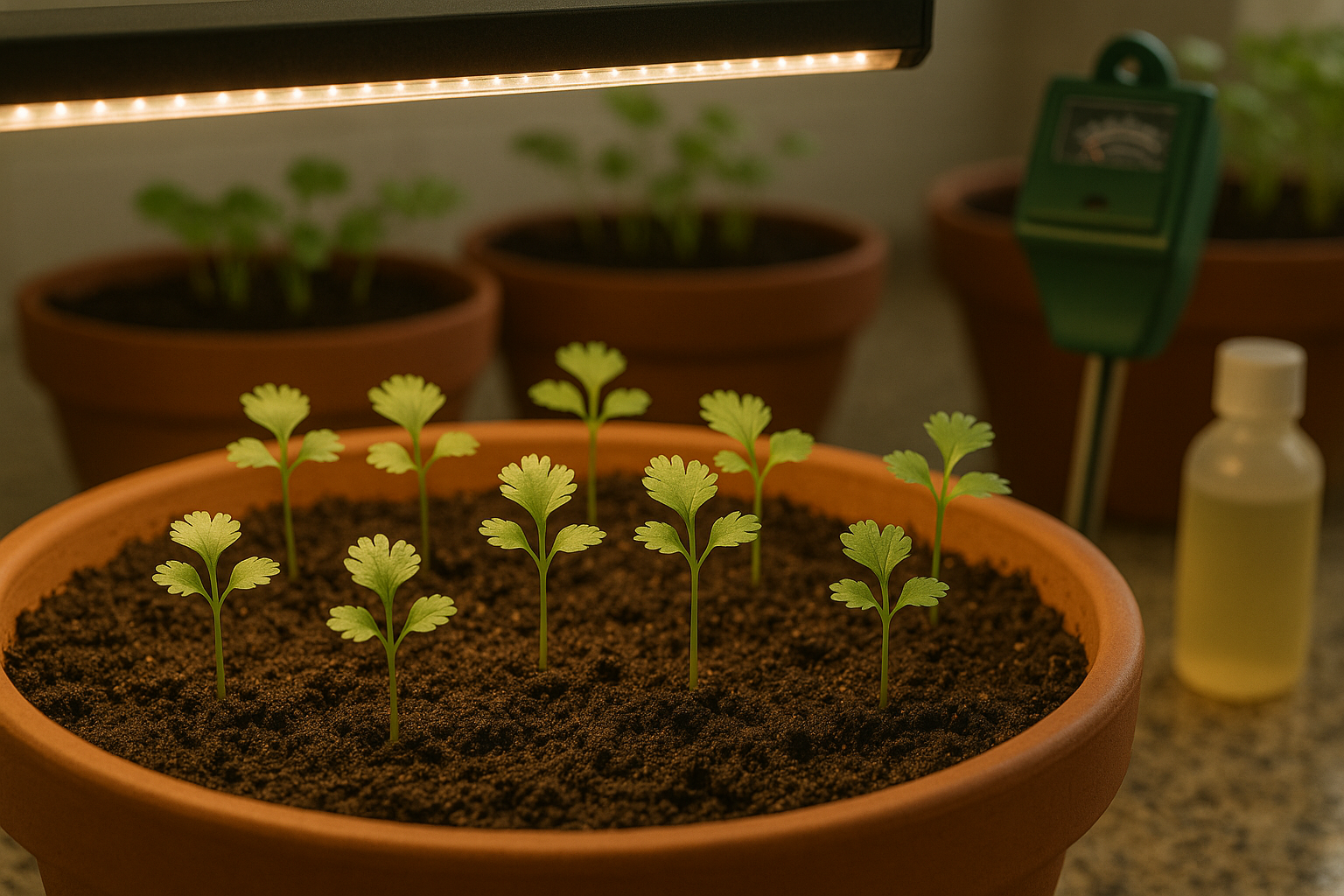
Planting cilantro indoors is a straightforward process that can yield fresh, flavorful herbs year-round with just a little planning. To start, choose a wide, shallow pot at least 8 inches deep and fill it with a well-draining potting mix enriched with a bit of compost.
Sow cilantro seeds about 1/4 inch deep, spacing them roughly an inch apart for optimal growth. If transplanting seedlings, set them with similar spacing so their roots don’t compete.
To maximize your harvest, try succession planting—sow new seeds every two to three weeks to ensure a continuous supply, as cilantro tends to bolt (flower and go to seed) quickly.
After sowing or transplanting, water the soil lightly but thoroughly, keeping it consistently moist (not soggy) until seedlings emerge, which usually takes about 7–10 days.
The best time to start cilantro seeds indoors is in early spring or late summer, when indoor temperatures are cooler (60–70°F), as cilantro prefers mild conditions and can struggle in heat.
Place pots near a sunny window or under grow lights for 4–5 hours of indirect light daily. Immediately after planting, keep the pot covered loosely with plastic wrap or a clear lid to maintain humidity, removing the cover as soon as the first shoots appear.
Remember to thin seedlings to about 2 inches apart once they’re a couple of inches tall, and gently mist the soil if it begins to dry out.
By following these simple steps, along with regular sowing, you’ll enjoy a steady crop of tender cilantro leaves for all your favorite dishes.
Cilantro Care
Cilantro, while flavorful and popular, can sometimes be tricky to grow indoors unless you provide just the right care—especially when it comes to water and light.
Water cilantro deeply but let the top inch of soil dry out before the next watering. In most indoor conditions, this is about every 3-4 days. Always check soil moisture with a finger test to avoid overwatering, which can lead to root rot and yellowing leaves. Signs your plant is thirsty include wilting leaves and dry soil, while limp, yellow, or drooping foliage usually means you’ve given it too much water. So, always err on the side of letting it dry out a little between waterings.
As for light, cilantro thrives in bright, indirect sunlight. A south- or east-facing window works best, but rotate the pot every few days so all sides get even exposure. If you don’t have enough natural light—at least 4-6 hours daily—supplement with a full-spectrum LED grow light, positioning it 6-12 inches above the plant for roughly 12-14 hours per day.
Cilantro likes light feeding: use a balanced, water-soluble fertilizer every 4-6 weeks at half strength to avoid salt buildup or leaf burn.
Watch for legginess—tall, spindly stems with sparse leaves—which usually means the plant isn’t getting enough light. If this happens, move it closer to a window or add a grow light.
Premature bolting, or suddenly sending up a flower stalk, often happens if the temperature climbs above 75°F or the plant is stressed. Keep cilantro cool and harvest leaves regularly to delay this process.
Pests like aphids or spider mites can sneak in—look for tiny specks or webbing. If you spot them, wash the leaves with a mild soapy solution or use neem oil.
By staying attentive to these care basics, you’ll keep your indoor cilantro lush, flavorful, and healthy for weeks instead of struggling with sad or stringy plants.
Harvesting and Extending Your Supply
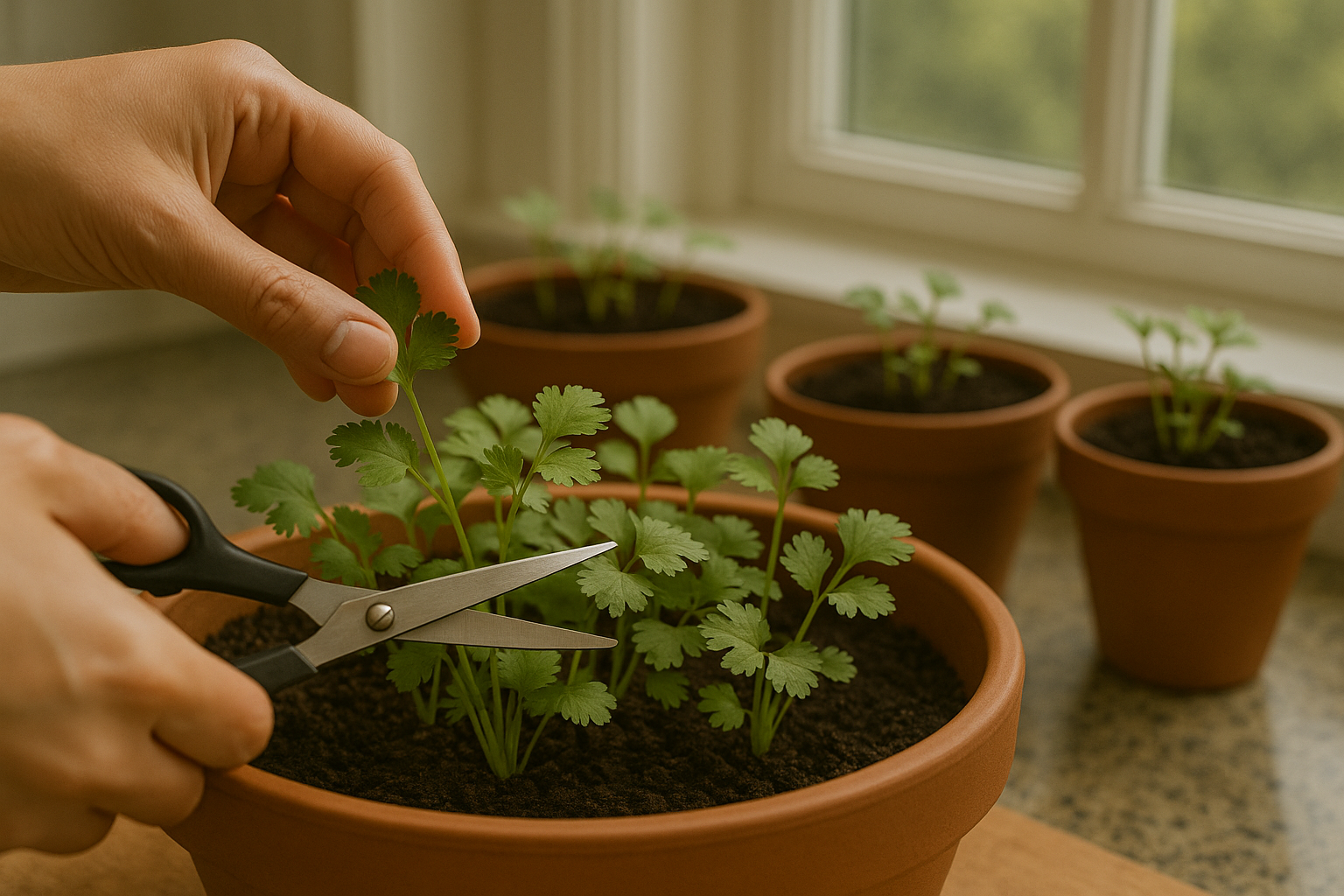
Timing your cilantro harvest just right can make a big difference in both flavor and longevity. For the freshest taste, start snipping the outer leaves once plants are about 6 inches tall and before flowering begins—typically 3 to 4 weeks after sprouting. Use clean scissors or pinch leaves with your fingers, always cutting the outermost stems first and leaving the inner growth to continue maturing.
This encourages your cilantro to bush out and regrow, rather than putting energy into seeding or fading early. If you harvest about a third of the plant at a time, you can expect fresh leaves every week or two.
Once the weather heats up or if the plant gets too much sun, cilantro may start to bolt, sending up tall flower stalks that shift the plant’s focus from leaves to seed production. When you spot a central stalk or feathery leaves, act swiftly: trim off the flower shoots to delay bolting and snip any remaining tender leaves.
However, if the plant bolts fully, let it go—keep watering and allow flowers to develop into seed heads. When they dry, you can collect coriander seeds for cooking or replanting.
For a non-stop supply indoors, practice succession sowing: every two to three weeks, start a fresh batch of seeds in a new pot or section of your planter. Aim for a staggered planting schedule so that as one crop matures or bolts, another batch is ready to pick. Choose a south-facing window or supplement with grow lights for the best results during low-light months.
With these techniques, you’ll enjoy a cycle of flavorful cilantro at your fingertips nearly year-round; just remember to keep soil moist but not waterlogged and harvest often to keep your plants producing lush, fragrant leaves.
Using and Storing Indoor-Grown Cilantro
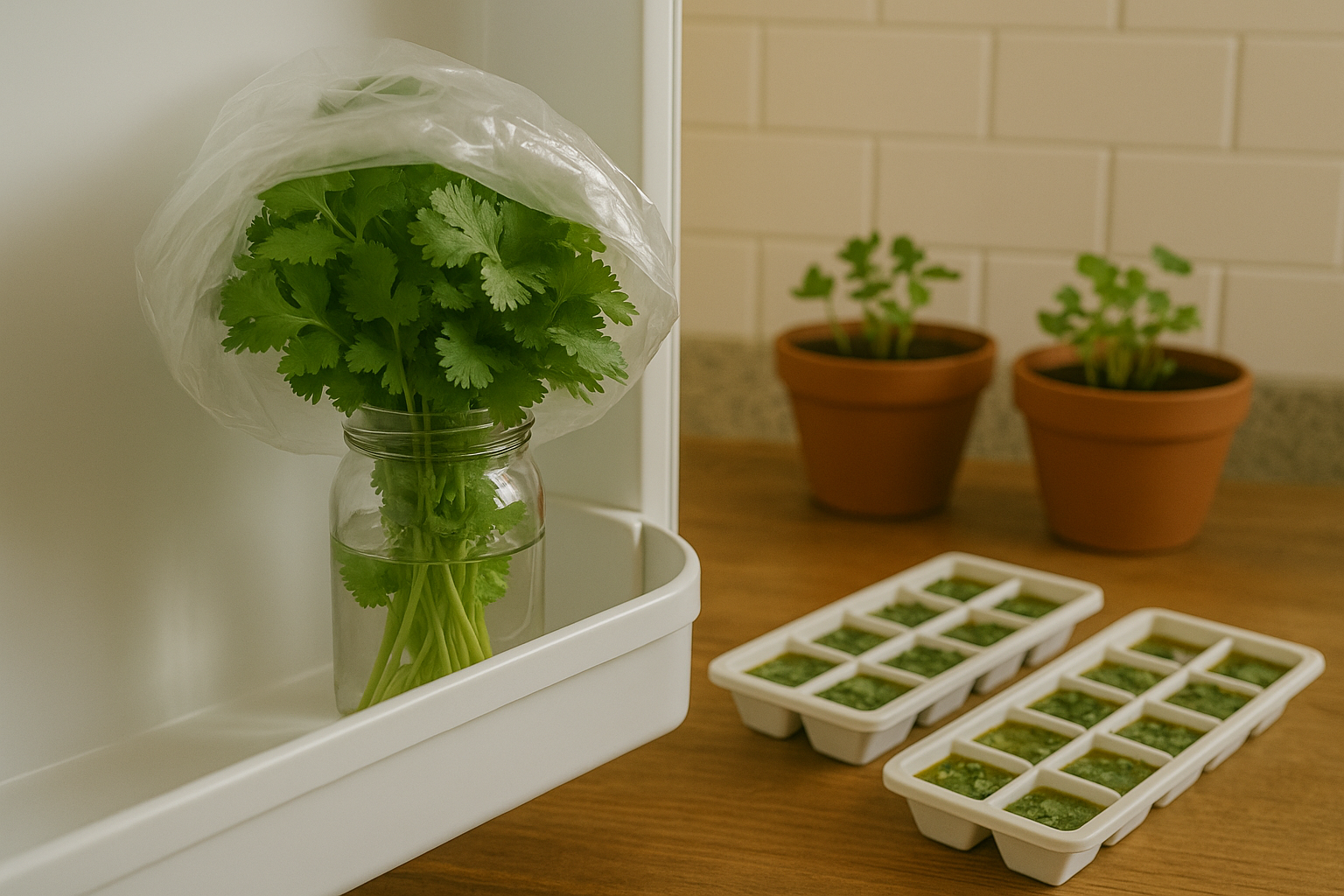
Fresh cilantro from your indoor garden can add a vibrant, herbal kick to dozens of dishes—think zesty guacamole, tangy salsa, bold curries, or even a simple garnish for tacos and soups. For quick weeknight meals, toss chopped leaves and tender stems into salads, blend into chimichurri, or stir into rice for an instant flavor boost.
When it comes to storage, keep cilantro fresh for up to a week by standing the stems upright in a glass of water (like a bouquet), loosely covering the leaves with a plastic bag, and storing it in the fridge—changing the water every few days for best results. Alternatively, you can wrap cilantro in a damp paper towel and seal it in a zip-top bag before refrigerating.
If you want long-term storage, you can dry cilantro by hanging bunches upside down in a dark, airy spot, but note that dried cilantro loses much of its signature zing. Freezing is a better option for preserving flavor. Simply wash and chop the cilantro, pack it into ice cube trays with a bit of water or olive oil, freeze, and pop out cubes as needed for soups, stews, or sauces.
Remember, cilantro stems are just as flavorful as the leaves; finely chop and add them to pesto or stir-fries to reduce waste. One common question is whether you should wash cilantro before storing—yes, but make sure it’s thoroughly dried first to prevent sogginess and spoilage.
By using both leaves and stems and following these storage methods, you’ll get the most out of your indoor cilantro harvest and enjoy fresh, punchy flavor in your cooking all year round.
